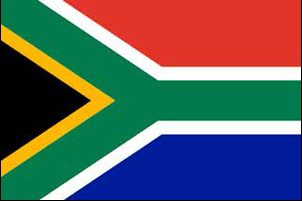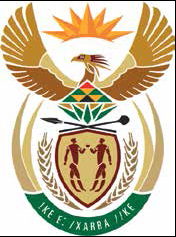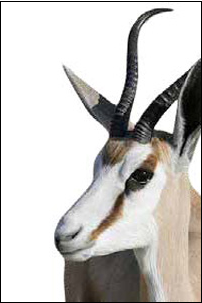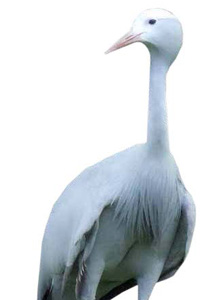South Africa is a diverse country with many cultures but also a deeply divided past.
 When the democratic government came into power in 1994, one of its biggest challenges was to unite the country and create a shared sense of identity. To help achieve this government introduced a range of national symbols, each symbolic of the country’s diverse cultures.
When the democratic government came into power in 1994, one of its biggest challenges was to unite the country and create a shared sense of identity. To help achieve this government introduced a range of national symbols, each symbolic of the country’s diverse cultures.
The South African flag
South Africa boasts one of the most colourful and unique flags in the world. The new national flag was first unveiled on 27 April 1994. Its design and combination of bright colours depicts the blend of a rainbow nation. The central ‘V’ shape also shows the coming together of different people and elements in South African society to take on the road ahead in unity.
The National Anthem
South Africa is the only country in the world to have a national anthem sung in five different languages - isiXhosa, isiZulu, Sesotho, Afrikaans and English. In 1997 the late former President Nelson Mandela decided that the country would have two official anthems - Nkosi Sikelel’ iAfrika (Lord bless Africa) and Die Stem van Suid-Afrika (the call of South Africa) - combined into one.
Nkosi Sikilel’ iAfrika was composed in 1897 by Methodist mission teacher Enoch Sontonga. It was first sung as a church hymn. Die Stem was written by local author Cornelis Jacobus Langenhoven in 1918.
The National Coat of Arms
A national Coat of Arms is a state’s emblem, which is used as a government symbol. It is also used on documents approved by the President and Government of South Africa, like birth certificates and identity documents. Launched on Freedom Day on 27 April 2000, the Coat of Arms design includes elephant tusks, a shield, spear, knobkerrie, human Khoisan figures, a bird, protea and the rising sun. The human Khoisan rock art figures symbolise a greeting in unity, with the motto “!KE E: / XARRA // KE”, which translated from the Khoisan language means diverse people unite.
National animal
The country’s national animal is the springbok. The springbok is known for withstanding various types of weather especially in the dry, open plains found across the country. They move in small herds during winter but can be found in large herds during the warmer seasons. The South African rugby team is also named after the national animal and is known as the Springboks.
National bird
South Africa is home to a variety of indigenous and exotic birds. One that stands apart, at almost a metre high, is the blue crane. These birds, which are light blue-grey in colour, are commonly found in the Karoo and parts of KwaZulu-Natal. The blue crane has a distinctive rattling, high-pitched croak that can be heard from miles away. Today there are a number of restaurants, lodges and awards named after this beautiful bird.
National tree
South Africa’s national tree is the real yellowwood tree, found along Table Mountain and the ravines of Drakensberg for more than a 100 million years. They grow up to 40 metres high and are up to three metres wide.
National fish
South Africa’s national fish is the galjoen. It is only found along the coast from Namibia to Durban. It lives in shallow water near the shore and is known to anglers as a game fighter. It is usually black but those that breed in sandy areas are silver-bronze.
National flower
A well-known symbol, the country’s national flower is the King Protea. It is the largest flower in the Protea family and is found in the Western Cape. The pink petals make the flower an important part of the Cape Floral Region - a World Heritage site. The country’s cricket team is named after the national flower and is known as the Proteas.
National Orders
The national orders are the highest awards that a country and its President bestows on deserving citizens who make remarkable discoveries and change the country for the better. South Africa has six national orders:
- The Order of the Mapungubwe, which is awarded for excellence and exceptional achievements that have had an international impact.
- The Order of the Baobab, which is awarded for distinguished service in the fields of business and the economy, science, medicine and technological innovation and community service.
- The Order of the Companions of OR Tambo, which is awarded to heads of state and other dignitaries for promoting peace, cooperation and friendship towards South Africa.
- The Order of Luthuli, which is awarded to South Africans who have made a meaningful contribution to the struggle for democracy, human rights, nation-building, justice, peace and conflict resolution. It symbolises the vision of the late Chief Albert Luthuli - the legendary liberation struggle leader and the first African recipient of the Nobel Peace Prize in 1961.
- The Order of Ikhamanga, which is awarded to South African citizens who have excelled in the fields of arts, culture, literature, music, journalism and sport.
- The Mendi Decoration for Bravery, which is awarded to South African citizens who have performed extraordinary acts of bravery.
Source : Department of Arts and Culture.






 Facebook
Facebook Twitter
Twitter WhatsApp
WhatsApp